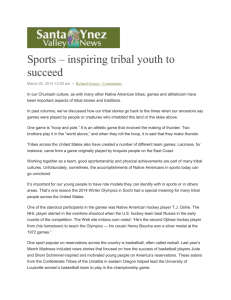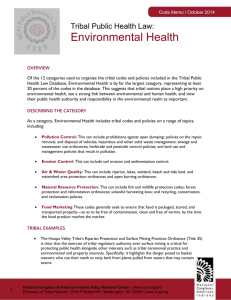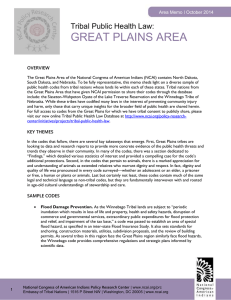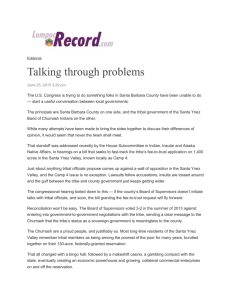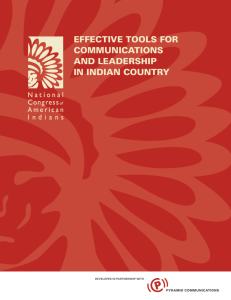Agriculture & Food Safety
advertisement
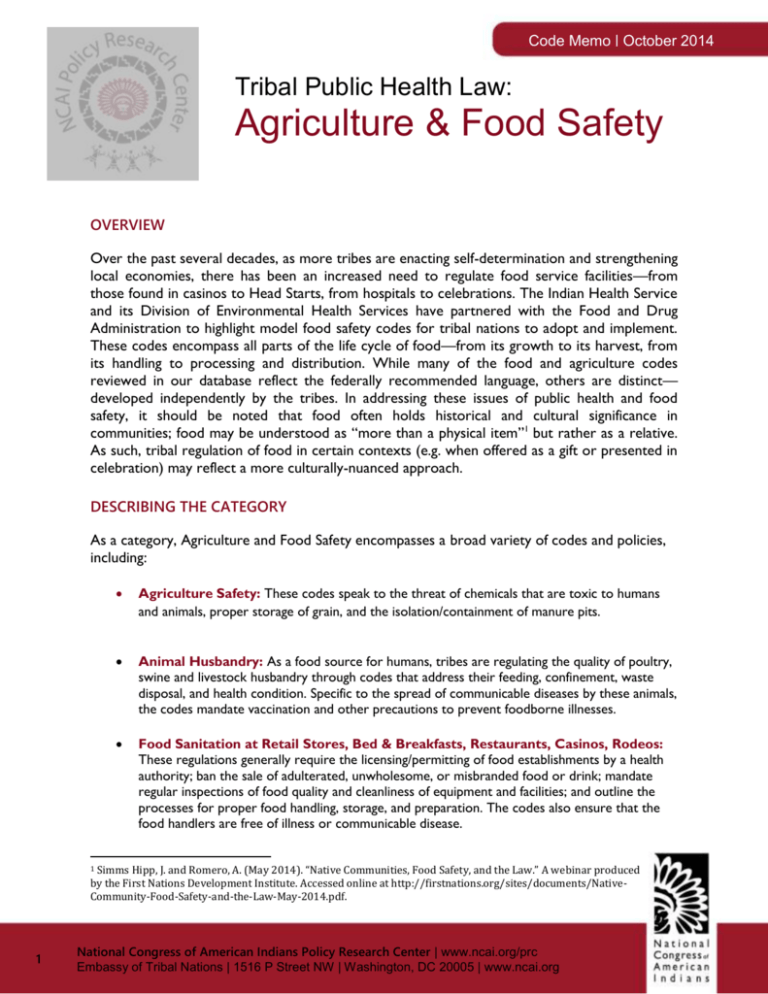
Code Memo | October 2014 Tribal Public Health Law: Agriculture & Food Safety OVERVIEW Over the past several decades, as more tribes are enacting self-determination and strengthening local economies, there has been an increased need to regulate food service facilities—from those found in casinos to Head Starts, from hospitals to celebrations. The Indian Health Service and its Division of Environmental Health Services have partnered with the Food and Drug Administration to highlight model food safety codes for tribal nations to adopt and implement. These codes encompass all parts of the life cycle of food—from its growth to its harvest, from its handling to processing and distribution. While many of the food and agriculture codes reviewed in our database reflect the federally recommended language, others are distinct— developed independently by the tribes. In addressing these issues of public health and food safety, it should be noted that food often holds historical and cultural significance in communities; food may be understood as “more than a physical item”1 but rather as a relative. As such, tribal regulation of food in certain contexts (e.g. when offered as a gift or presented in celebration) may reflect a more culturally-nuanced approach. DESCRIBING THE CATEGORY As a category, Agriculture and Food Safety encompasses a broad variety of codes and policies, including: Agriculture Safety: These codes speak to the threat of chemicals that are toxic to humans and animals, proper storage of grain, and the isolation/containment of manure pits. Animal Husbandry: As a food source for humans, tribes are regulating the quality of poultry, swine and livestock husbandry through codes that address their feeding, confinement, waste disposal, and health condition. Specific to the spread of communicable diseases by these animals, the codes mandate vaccination and other precautions to prevent foodborne illnesses. Food Sanitation at Retail Stores, Bed & Breakfasts, Restaurants, Casinos, Rodeos: These regulations generally require the licensing/permitting of food establishments by a health authority; ban the sale of adulterated, unwholesome, or misbranded food or drink; mandate regular inspections of food quality and cleanliness of equipment and facilities; and outline the processes for proper food handling, storage, and preparation. The codes also ensure that the food handlers are free of illness or communicable disease. Simms Hipp, J. and Romero, A. (May 2014). “Native Communities, Food Safety, and the Law.” A webinar produced by the First Nations Development Institute. Accessed online at http://firstnations.org/sites/documents/NativeCommunity-Food-Safety-and-the-Law-May-2014.pdf. 1 1 National Congress of American Indians Policy Research Center | www.ncai.org/prc Embassy of Tribal Nations | 1516 P Street NW | Washington, DC 20005 | www.ncai.org Code Memo | October 2014 Child Day Care Facilities: Although they were not considered initially, several tribal codes with child care facility licensing requirements explicitly referenced food sanitation. The premises of these mandates are similar, yet contain far more specificity in ensuring child welfare. Food Marketing These codes generally seek to ensure that food is packaged, stored, and transported properly—so as to be free of contamination, clean and free of vermin, by the time the food product reaches the market. Any policies that relate to the genetic modification of foods were not included in this category; rather, they were coded as Human and Cultural Resource Protection. Another policy from the Fond du Lac Band of the Minnesota Chippewa Tribe that addressed the reduction of fats, oils, and grease in food preparation was placed in the category of Environmental Health, as their concern was for discharges into wastewaters and associated impacts on public health infrastructure. TRIBAL EXAMPLES As subsistence fishing is a treaty-protected right valued by the Leech Lake Band of Ojibwe, the tribe has implemented a code defining a “subsistence threshold mercury fish tissue concentration consumption guideline of 0.02 parts per million (ppm) based on 180 pounds of fish per year…to provide for the health, welfare, and treaty rights of tribal members.” They developed this threshold with the data-driven understanding that “0.5 ppm of mercury is safe for women and children.” The Confederated Tribes of the Umatilla Indian Reservation implemented a model code in regulating animal husbandry, requiring owners to provide livestock “with adequate feed and fresh water to maintain health, weight, and vigor”. Injured or diseased animals must receive “veterinary care to relieve pain, suffering, and prevent the spread of disease.” The tribe has also banned Confined Animal Feeding Operations (CAFOs) “due to the potential for serious degradation of land, water, and air resources and for devastating impacts to human health.” From the Jamestown S’Klallam Tribe, we gain two examples of how food safety is approached in the context of communal celebrations. The language of these codes appears to balance tribal liability with cultural custom and norms. In their Tribal Food Code it states: “Volunteers working as food handlers on an irregular basis on Tribal Non-Fee Land and associated facilities, such as a Tribal picnic, are not required to have a Food Worker Card. However, their activities shall be overseen at all times by a supervisor with a current Food Worker Card.” 2 National Congress of American Indians Policy Research Center | www.ncai.org/prc Embassy of Tribal Nations | 1516 P Street NW | Washington, DC 20005 | www.ncai.org Code Memo | October 2014 “Tribal staff or Tribal citizens who choose to purchase or accept donated shellfish, fish, or game meat for their own use from vendors not in compliance with this Title will do so at their own risk.” Their Food Code also provides us with an example of a mutual aid agreement (the Olympic Regional Tribal-Public Health Mutual Assistance Agreement), which would come into effect if there was a foodborne disease outbreak on tribal lands. The Tohono O’odham Tribe adopted a code in 1960 titled, “Regulations Governing Sanitation at Eating and Drinking Establishments”—broadly applying to all employees, food equipment, “kitchens or other places in which food or drink is prepared for sale,” in addition to “itinerant restaurants…operating for a temporary period in connection with a fair, rodeo…or public exhibition.” Each establishment must procure and display a permit and be subject to routine food, drink, and other sample inspections by the Health Advisor to detect “unwholesomeness or adulteration.” The walls in all food preparation rooms must be “finished in light color”; doors must be self-closing “to prevent the entrance of flies”; and employees shall not spit “or use tobacco in any form” in proximity to food. The Hoopa Valley Tribe, on the other hand, has approached the regulation of informal markets somewhat differently. As defined, a regulated food establishment includes any mobile or temporary facility “regardless of whether there is a charge for food,” but exempts “a kitchen in a private home if only food that is not potentially hazardous is prepared for sale or service at a function such as a religious or charitable organization’s bake sale.” In this latter case, however, the consumer is informed by a visible placard that the food product has not been inspected. As an example from the Plains, the Sisseton-Wahpeton Oyate has issued a general Food Sanitation Code, one that applies specifically to Retail Food Stores, and one for Child Care Facilities. While the former two contain standard protections, the Child Care Ordinance details requirements for the disinfection of all food preparation and serving surfaces, the size of food so as to not induce choking, the proper handling of breast milk, for safe drinking water, etc. NOTES FOR THE FIELD 3 Protecting treaty rights to subsistence foods is equally as important, if not more so, than protecting public health in their consumption. Connected to the understanding of food as a relative, various tribal codes we reviewed emphasized dignified and humane treatment of the animals that serve as our protein sources. National Congress of American Indians Policy Research Center | www.ncai.org/prc Embassy of Tribal Nations | 1516 P Street NW | Washington, DC 20005 | www.ncai.org Code Memo | October 2014 4 Food is as much about public health as it is about public good and the value of this resource as a connection to place and to the land. Tribal codes in the domain of public health and emergency management reflect a willingness to engage in intergovernmental cooperative agreements so as to safeguard the broader publics from foodborne contagions. As tribes frequently host celebrations, they are developing codes to include provisions for the safe consumption of homemade foods, wild caught fish and game, etc. Beyond formal regulations for restaurant and gaming facilities, these informal sites of interaction with food warrant attention from the broader field of public health—particularly in ways that preserve the cultural integrity of these community gatherings. National Congress of American Indians Policy Research Center | www.ncai.org/prc Embassy of Tribal Nations | 1516 P Street NW | Washington, DC 20005 | www.ncai.org



